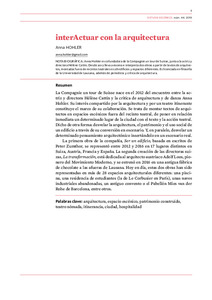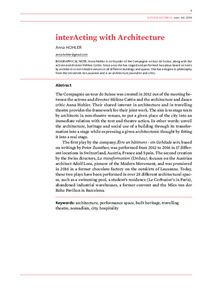| dc.contributor.author | Hohler, Anna | |
| dc.date.accessioned | 2021-01-29T10:18:51Z | |
| dc.date.available | 2021-01-29T10:18:51Z | |
| dc.date.issued | 2019 | |
| dc.identifier.issn | 2385-362X | |
| dc.identifier.issn | 0212-3819 | |
| dc.identifier.uri | http://hdl.handle.net/20.500.11904/1199 | |
| dc.description.abstract | <p>The Compagnie un tour de Suisse was created in 2012 out of the meeting between the actress and director Hélène Cattin and the architecture and dance critic Anna Hohler. Their shared interest in architecture and in travelling theatre provides the framework for their joint work. The aim is to stage texts by architects in non-theatre venues, to put a given place of the city into an immediate relation with the text and theatre action. In other words: unveil the architecture, heritage and social use of a building through its transformation into a stage while expressing a given architectonic thought by fitting it into a real stage.</p>
<p>The first play by the company, <em>Être un bâtiment - ein Gebäude sein</em>, based on writings by Peter Zumthor, was performed from 2012 to 2016 in 17 different locations in Switzerland, Austria, France and Spain. The second creation by the Swiss directors, <em>La transformation (Umbau)</em>, focuses on the Austrian architect Adolf Loos, pioneer of the Modern Movement, and was premiered in 2016 in a former chocolate factory on the outskirts of Lausanne. Today, these two plays have been performed in over 28 different architectural spaces, such as a swimming pool, a student’s residence (Le Corbusier’s in Paris), abandoned industrial warehouses, a former convent and the Mies van der Rohe Pavilion in Barcelona.</p> | |
| dc.description.abstract | <p>La Compagnie un tour de Suisse nace en el 2012 del encuentro entre la actriz y directora Hélène Cattin y la crítica de arquitectura y de danza Anna Hohler. Su interés compartido por la arquitectura y por un teatro itinerante constituye el marco de su colaboración. Se trata de montar textos de arquitectos en espacios escénicos fuera del recinto teatral, de poner en relación inmediata un determinado lugar de la ciudad con el texto y la acción teatral. Dicho de otra forma: desvelar la arquitectura, el patrimonio y el uso social de un edificio a través de su conversión en escenario. Y, en paralelo, desvelar un determinado pensamiento arquitectónico insertándolo en un escenario real.</p>
<p>La primera obra de la compañía, <em>Ser un edificio</em>, basada en escritos de Peter Zumthor, se representó entre 2012 y 2016 en 17 lugares distintos en Suiza, Austria, Francia y España. La segunda creación de las directoras suizas, <em>La transformación</em>, está dedicada al arquitecto austriaco Adolf Loos, pionero del Movimiento Moderno, y se estrenó en 2016 en una antigua fábrica de chocolate a las afueras de Lausana. Hoy en día, estas dos obras han sido representadas en más de 28 espacios arquitecturales diferentes: una piscina, una residencia de estudiantes (la de Le Corbusier en París), unas naves industriales abandonadas, un antiguo convento o el Pabellón Mies van der Rohe de Barcelona, entre otros.</p> | |
| dc.relation.ispartof | Estudis escènics: quaderns de l'Institut del Teatre. 2019, Núm. 44 | |
| dc.title | interActing with Architecture | |
| dc.type | Article | |
| dc.date.updated | 2021-01-29T10:18:52Z | |
| dc.rights.access | Open Access | |



